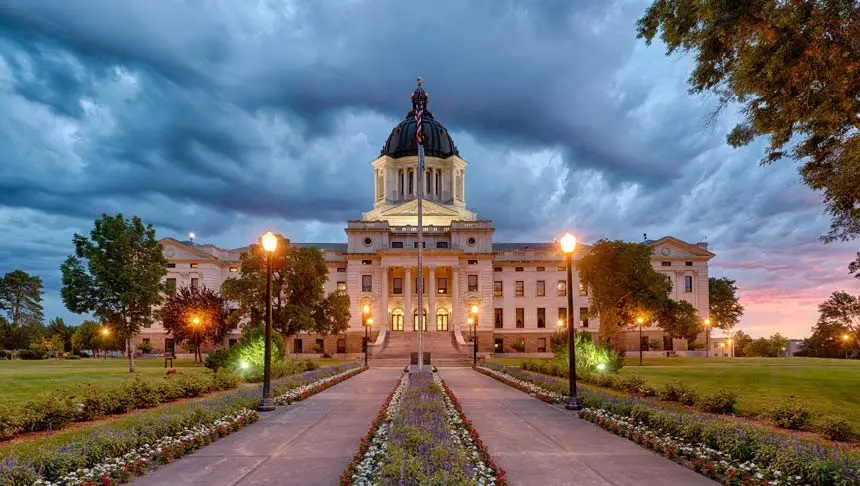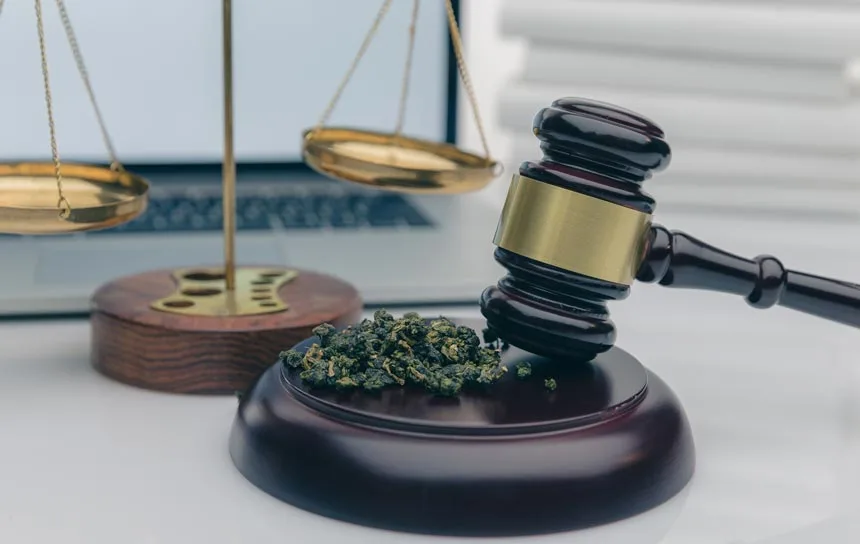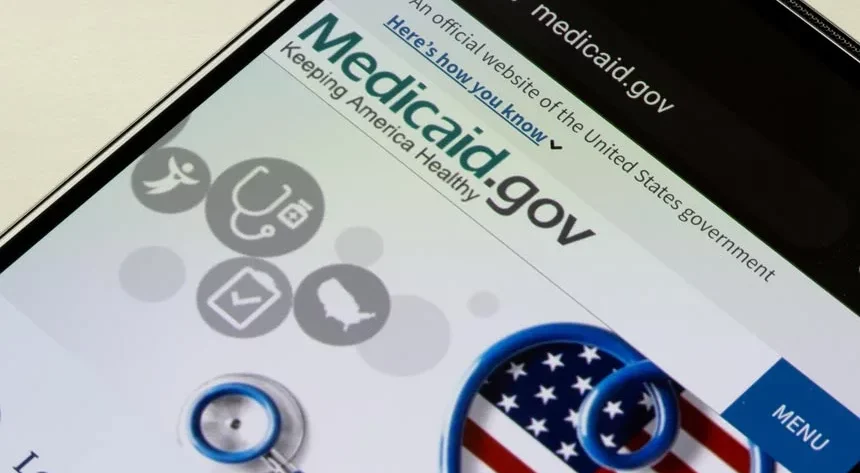In a given year, approximately 107,000 South Dakotans – 12.14 percent of the state population – used illegal substances, while another 53,000 – 6.01 percent of the state population – abuse alcohol. From these statistics, the need for effective South Dakota alcohol and drug rehab centers is clear.
Drugs and alcohol were responsible for 17.27 percent of all mortalities in South Dakota between 2008 and 2017, more than four full percentage points higher than the national average of 12.71 percent.
During the same time period, the most populated city in South Dakota, Sioux Falls, had a 17.86 percent drug- and alcohol-related fatality rate.
This resource was created to assist South Dakota individuals who are battling with substance abuse and addiction in locating affordable treatment that will put them on the road to recovery. It is also meant to educate the general population in South Dakota about the hazards of substance usage.
Options for Alcohol & Drug Rehab in South Dakota
Table of Contents
- Options for Alcohol & Drug Rehab in South Dakota
- The Rising Need for South Dakota Addiction Treatment
- Top Substances of Abuse in SD
- South Dakota Drug Laws
- Federal Drug Sentencing and South Dakota
- Cannabis Laws in South Dakota
- South Dakota Addiction Treatment Laws
- The 24/7 Sobriety Program in South Dakota
- How Much Does Rehab Cost in South Dakota?
- Dual Diagnosis Treatment Centers in South Dakota
- Addiction Aftercare Services in South Dakota
- 12-Step Addiction Meetings in South Dakota
- SD Sober Living Homes
- Factors that Can Cause Substance Abuse: South Dakota
- Traveling to South Dakota for Rehab
- Traveling from South Dakota to an Out of State Rehab
- Find the Right South Dakota Alcohol and Drug Rehab Centers Now
When you recognize that you have a problem, you are already on the road to healing. The following step is to select how to become sober. This is especially tough since you may be unsure whether your addiction is severe enough to warrant admission to a rehabilitation clinic.
The issue is that many people refuse therapy because they do not believe their addiction is severe enough. The truth is that if you’re debating whether or not to become sober, you probably should.

As part of a “continuum of care,” there are five stages of addiction treatment:
- Pre-Level 1: Early intervention services
- 2nd Level: Outpatient services
- 3rd Level: Intensive outpatient or partial hospitalization services
- 4th Level: Residential or inpatient treatment services
- 5th Level: Medically managed intensive inpatient treatment services
Medical Detox
Medical detox is typically included in medically controlled intensive inpatient treatments. This is when your withdrawal symptoms will be treated in order for your body to be totally cleansed of the substance to which you are addicted.
Inpatient Rehab Programs
You will be forced to live at the treatment center during these sessions. After medical detox, this is the greatest level of care, often known as residential treatment. This is usually the best option if you want to travel to South Dakota for treatment. You and the other members will be surrounded by medical specialists for 24 hours.
If you require medical care while receiving inpatient services, it will be provided immediately. This type of therapy has the best success rate, but it is also more expensive than other types of treatment. These programs range in length from 28 to 90 days.
Outpatient Rehab & Treatment

Outpatient programs are slightly longer but less rigorous. These recovery programs often necessitate 10 to 12 hours per week spent at a local treatment center. You will concentrate on substance misuse education, individual and group counseling, and learning how to live without your preferred drug.
These programs are an excellent choice if you have a mild addiction or as a follow-up to an inpatient program. Outpatient treatment allows you to continue with your everyday family, job, or school obligations while receiving treatment. Expect to be in an outpatient program for three to six months, or up to a year.
Intensive outpatient programs (or IOPs) are more intensive than standard outpatient programs and necessitate a greater commitment from the participant, up to sixteen hours per week.
The Rising Need for South Dakota Addiction Treatment
Drug trafficking organizations (DTOs), which transfer drugs over and within state lines, have been linked to the recent rise in overdoses in South Dakota. In order to take advantage of the rising number of South Dakotan youngsters interested in drug experimentation, several DTOs have refocused their distribution efforts in the state’s major cities, such as Sioux Falls.
63 drug-related overdose deaths occurred in South Dakota in 2014, up from 55 in 2013. These overdoses on heroin or other opiates were to blame for the vast majority of these fatalities.
Drug Trafficking in South Dakota
width="100%" height="550" frameborder="0" allowfullscreen="allowfullscreen">
Black tar heroin, methamphetamine, cocaine, and marijuana make up the majority of the state’s drug supply, which is primarily imported from the northwest and Canada via commercial trucks and personal vehicles.
Another widely used substance among young people in South Dakota is 25i, a synthetic hallucinogen with effects similar to LSD. Although reports of the synthetic substance have been made around the nation since 2010, South Dakota just began to record cases of use in 2015. The substance is difficult to identify using a drug analysis and is available in both powder and liquid forms.
Because they think it is less harmful to take than drugs like cocaine or ecstasy, many young people are drawn to 25i. However, research has shown that 25i is highly addictive and that it can cause unpredictable physical side effects as well as violent, erratic behavior. Hallucinogen experimentation, such as with 25i, might eventually result in a drug addiction to more dangerous substances.
Top Substances of Abuse in SD
Even the first time consuming a substance might result in a developing substance use disorder. People in South Dakota seek treatment each year for addictions to one or more of the following substances:
- Alcohol
- Cocaine
- Marijuana
- Heroin
- Other opiates, such as prescription medications
- Stimulants like methamphetamine
South Dakota Drug Laws

The criminal justice system in South Dakota is strict and unforgiving when it comes to drug-related offenses. Drug possession, selling, and manufacturing offenses are penalized by steep fines, protracted prison terms, or a combination of the two.
In South Dakota, a drug conviction can have long-term repercussions that go well beyond the time served in prison. Offenders risk losing their driving privileges or a scholarship for education. Additionally, they can have a harder time getting acceptable employment.
Based on their propensity for misuse and accepted medicinal use, substances are grouped into one of four schedules to establish the proper penalties for drug offenses in South Dakota.
Federal Drug Sentencing and South Dakota
Schedule I drugs include things like heroin, benzethidine, dextromoramide, phenomorphan, and methaqualone. These drugs have the highest potential for abuse and have no accepted medical purpose in the US.
Pharmaceuticals classified as Schedule II are those that have a high potential for misuse and are only permitted for medical use under very specific guidelines. A couple of examples of category II medications are fentanyl and methadone.
Drugs in schedule III are less addictive than those in schedule I or II, but they are well-researched and approved for medical use. This group includes stimulants like benzphetamine and ephedrine.
Schedule IV drugs are totally permissible in a medical setting and have a lower risk for abuse. Alprazolam and other benzodiazepines fit into this category.
Any amount of a Schedule I or II substance in possession, sale, or manufacturing is a Class 4 felony punishable by a fine of up to $20,000 and/or ten years in prison. However, the punishment is increased to a Class 3 Felony (with a maximum term of 15 years in prison and a fine of $30,000) if law enforcement finds the following at the scene.
- A knife, a gun, or another potentially lethal handgun.
- Cash wards worth no less than $300.
- Materials in bulk used to package medications.
- Recipes, chemical precursors, lab supplies, ventilation, or any other machinery used in production or cultivation.
- Customer lists or records of drug transactions.
If selling to a minor was a part of the schedule I or II drug offense, the offender would be guilty of a Class 2 Felony, punishable by up to 25 years in prison and a $50,000 fine.
Schedule III or IV crimes are no longer taken lightly. Schedule III drug violations are punishable by a Class 5 felony, which entails a five-year prison term and a $10,000 fine. A Class 6 Felony conviction for using a Schedule IV substance carries a maximum sentence of two years in jail and a fine of $4,000.
Cannabis Laws in South Dakota

Marijuana of any kind cannot be owned, sold, or grown in South Dakota. Depending on the type of infraction, defendants can anticipate time in jail and a substantial fine.
Additionally, there is a requirement for “internal possession” in South Dakota. Even if you ingested marijuana in a state like Colorado where it is legal for recreational use, you can still be jailed for having it in your system.
South Dakota Addiction Treatment Laws
Like the rest of the nation, South Dakotans have suffered greatly from fatal heroin or opiate overdoses. New legislation is being implemented as a result to help those who are in danger of overdosing get care.
The first naloxone access bill in South Dakota, Senate Bill 14, was passed there in 2015. It permits medical first responders to carry naloxone in case of an opioid overdose.
Naloxone is an opioid antagonist medication that, when administered properly, reverses the effects of a heroin or opiate overdose.
Another law that let family members, friends, and other loved ones to administer the medication to someone who was in danger of an opioid overdose was approved in 2016.
Thousands of times around the nation, naloxone has been used to save lives following overdoses on heroin, morphine, or other opioids. Naloxone does not, however, treat opioid addiction. It is advised that a person get therapy after recovering in the emergency room in order to avoid another overdose.
Another essential element of South Dakota’s plan to address opioid addiction is methadone maintenance programs. It functions by reducing the withdrawal symptoms experienced by heroin or opioid addicts while leaving the “high” associated with such drugs unaffected. Methadone is widely utilized as part of an individual’s ongoing addiction therapy since it has been proven to be beneficial as part of a heroin or opiate detox program. There are presently two methadone maintenance clinics in South Dakota.
The 24/7 Sobriety Program in South Dakota

Addiction can result from drug or alcohol abuse and present major health risks. Some people engage in criminal activities including robbery, domestic violence, and drunk driving as a result of abusing alcohol or drugs. In South Dakota, the 24/7 Sobriety program works to address these issues and put people’s lives back on track.
The state’s 24/7 Abstinence Program helps people achieve and maintain sobriety from drugs or alcohol as well as reduce rising crime rates.
When a person is found guilty of a crime involving drugs or alcohol, they are given the option of entering the program rather than doing time in jail. Participants are required to submit to drug tests or breathalyzer tests twice day, or to wear an alcohol monitoring bracelet or patch. If they fail or skip an exam, they are sent to prison.
Since the program’s beginning in 2005, it has had over 42,000 participants and a graduation rate of 99.1 percent. Recidivism and criminal activity are less common among program graduates than among nonparticipants.
How Much Does Rehab Cost in South Dakota?
Substance abuse therapy is the most effective approach to break a drug or alcohol addiction, but the expense of treatment can be prohibitively expensive for some. Medicaid and other kinds of health insurance are some of the primary ways that treatment is paid for in the state, but many people are still struggling to overcome their addiction.
With the rise of the drug epidemic has come an increase in the number of drug rehab programs and ways to pay for the necessary treatment to end drug or alcohol addiction.
Paying for Treatment with Medicaid in South Dakota

Medicaid is a sort of government-funded health insurance that offers basic drug and alcohol treatment services to all patients. Outpatient, medical detoxification, in-patient, and long-term residential programs are examples of such programs. The programs that are funded by the government Medicaid frequently experiences an inflow of patients, which might result in a treatment wait list if the facility is at capacity. This is not to say that there will be no possibilities; nonetheless, it may be more difficult in some circumstances. Medicaid will know which services will be available in your area.
Using Private Insurance to pay for Drug Rehab in South Dakota
Drug users will have access to drug and alcohol treatment clinics with the support of a private health insurance policy, which can be partially or totally funded by the insurance provider. To cover treatment, private health insurance carriers collaborate with specialized drug and alcohol treatment institutions.
Coverage will be determined by the individual’s policy as well as the programs that work directly with the insurance provider. Find Addiction Rehabs will be able to tell you which programs they cover and what your expected out-of-pocket payments will be, if any. Private health insurance frequently collaborates with some of the best drug recovery programs and or recovery representatives can quickly and confidentially help you locate treatment both in the Dakotas and nationwide.
Paying for treatment when uninsured
Despite the availability of numerous insurance alternatives, many residents in the United States, including South Dakota, remain uninsured. And, while insurance often provides the most cost-effective alternatives for addiction recovery services, persons without health insurance have other options.
Patients using self-pay programs are not required to have insurance and can usually work with a payment plan for treatment. A sliding scale is another option for making treatment more reasonable. It works by using an individual’s income to decide the cost of the program, ensuring that all patients have the option of enrolling in affordable drug treatment.
Dual Diagnosis Treatment Centers in South Dakota

The term “co-occurring substance use and mental health disorders” refers to the frequent coexistence of substance abuse and mental health issues. The Substance Abuse and Mental Health Services Administration (SAMHSA) reports that in 2017, 18.3 percent of people with a mental health illness also had a substance use disorder, and 45.6% of those with a substance use disorder also had a mental health issue. In 2017, 10.7% of adolescents with a major depressive episode also had a drug use disorder, compared to 35.9% of adolescents with substance use problems who also experienced a major depressive episode.
Addiction Aftercare Services in South Dakota
Although it is a crucial step in the recovery process, substance abuse aftercare treatment is occasionally overlooked. People who try to carry on with their lives without receiving additional care in an aftercare setting greatly increase their risk of relapsing after rehab.
A variety of aftercare options are available for recovering addicts, including group therapy, follow-up sessions for ongoing therapy, and sober living facilities. Long-term participation in aftercare programs greatly enhances the success of rehabilitation efforts, according to study.
12-Step Addiction Meetings in South Dakota

There are now many 12-step groups for different addictions and disorders, with Narcotics Anonymous (NA) being only one example. Alcoholics Anonymous (AA) originated the 12-step technique for those recovering from alcohol addiction, but it has now been adopted by many other organizations.
SD Sober Living Homes
Group homes that help recovering addicts move from treatment facilities to independent living while keeping their sobriety are known as sober living houses (also known as recovery residences). People who don’t have a supportive and joyful environment to live in after leaving a rehabilitation institution may benefit greatly from these homes.
Because these facilities frequently have a zero-tolerance drug and alcohol policy, residents can stay for a few months to several years in a sober living home as long as they abide by the house rules and don’t relapse. Additionally, residents are required to complete tasks, participate in mutual support organizations, and pay an equal portion of the rent.
Factors that Can Cause Substance Abuse: South Dakota
When seeking to comprehend drug addiction concerns in a certain place, researchers and policymakers look at “key indicators.” Key indicators can offer profound insight into which substances represent the greatest risks and which populations are most affected by substance abuse when paired with usage information. The following discussion examines the main indicators of South Dakota’s substance abuse problems as well as current, accurate statistics.
South Dakota’s Mental Health Problem

As was said before in this article, there is a significant connection between substance use issues and mental health disorders. Co-occurring drug use and mental health disorders, also referred to as a “dual diagnosis,” are when a person experiences both of these issues at the same time. As a result, we may be able to gauge the level of substance use by looking at how common mental health issues are in a certain state.
In South Dakota, the incidence of major mental disorders in 2017–2018 was 4.6%, in line with the national average of 4.6%. 6.4 percent of adults in South Dakota suffered a major depressive episode in the previous year, compared to 7.1 percent nationally.
South Dakota’s Rate of Opioid Prescriptions
In America, the misuse of prescription medications, particularly the abuse of opioids, has reached pandemic proportions. The Centers for Disease Control and Prevention studied the variation in opioid prescriptions across states and discovered a direct correlation between an increased level of opioid prescriptions and a higher risk of dependence and abuse, even though it is difficult to estimate how many people use these drugs as prescribed and how many abuse them. In the United States, doctors prescribed 191 million opioids in 2017. As a result, one in every four individuals who start long-term opioid medication develop an addiction.
Due to the growth of the opioid epidemic and the recognition of the role that excessive opioid prescriptions have played in this pandemic, the opioid prescribing rate in the United States has been steadily dropping for several years after peaking in 2012. In the United States, the rate of opioid prescriptions decreased from 78.1 per 100 residents in 2013 to 58.7 per 100 residents in 2017, a decrease of 24.84 percent. South Dakota’s opioid prescribing rate dropped from 60.6 per 100 residents in 2013 to 49 per 100 residents in 2017, a 19.14 percent decline, during that time period, remaining consistently lower than the national prescribing rate.
Traveling to South Dakota for Rehab

Mount Rushmore, one of the most iconic monuments in the country, is located in South Dakota and has 60-foot sculptures of the heads of past U.S. presidents George Washington, Thomas Jefferson, Theodore Roosevelt, and Abraham Lincoln carved into the face of the mountain.
Fishing and hunting are popular pastimes in South Dakota, which has a diverse game population that includes pheasants, white-tailed deer, mule deer, and turkeys. Anglers love catching Walleye, Chinook, Salmon, and Trout across the state.
Traveling from South Dakota to an Out of State Rehab
Many people in South Dakota have found their way back to recovery as a result of the numerous programs available across facilities. But everyone is unique. A program that works for someone else may not be suitable for you. That is why it is critical to investigate all therapy alternatives, especially those located distant from home.
Those who are willing to travel for treatment have many more possibilities, allowing them to be more selective when selecting the right clinic. Traveling for rehab might also help you put distance between yourself and the environment that generated your addiction in the first place.
Treatment Center Accreditations in South Dakota
Many addiction treatment centers go through the accreditation process in order to give quality care to their patients. At the very least, all recovery clinics must meet state licensing criteria. Quality addiction treatment centers, on the other hand, will invest time and money on a series of evaluations in order to establish a standard of excellence in client care. An accredited facility is certified by a third-party accrediting authority recognized in the industry.
A facility that bears the seal of accreditation and certification has been evaluated by the most reputable organizations in the field of addiction and mental health treatment.
A number of organizations oversee the accreditation of rehabilitation institutions and providers. Accreditation takes time and money for a treatment center. Before granting accreditation, the agency will assess a facility’s staff, programs, client care, operations, and policies to ensure they satisfy the agency’s requirements and are in conformity with privacy laws.
Three major organizations provide accreditation:
The Substance Use Disorder Prevention that Promotes Opioid Recovery and Treatment Act of 2018 for Patients and Communities (SUPPORT) certifies that patients’ treatment and care follow nationally accepted requirements for quality and uniform behavioral health care.
The Commission on Accreditation of Rehabilitation Centers (CARF) can assist you in locating an accredited facility or practitioner as well as evaluating addiction treatment facilities in the United States and Canada.
The Joint Commission Accreditation for Addiction Treatment Providers (Joint Commission) is the largest medical facility and hospital accrediting authority, as well as the second-largest substance abuse program.
Find the Right South Dakota Alcohol and Drug Rehab Centers Now
You are not alone whether you are suffering addiction or are concerned about a loved one’s substance usage. People all over the country battle with drug addictions such as alcohol, cocaine, heroin, prescription pills, and others, but professional addiction therapy is available to help.
Substance abuse treatment encompasses a wide range of services and programs designed to meet the needs of individuals with varying demands. People with mild to severe addictions can obtain therapy at various levels of care. Speciality programs address the specific requirements of people who may require additional assistance in order to achieve long-term rehabilitation. Some folks may be seeking for treatment centers with certain facilities or services to make their recovery process easier.
Find Addiction Rehabs knows all about the best drug and alcohol treatment programs in South Dakota and across our country. Reach out today and let us break down what to expect and help you find the program and treatment facility that suits your needs, quickly and confidentially.
Give yourself a break and call our compassionate recovery representatives now!

